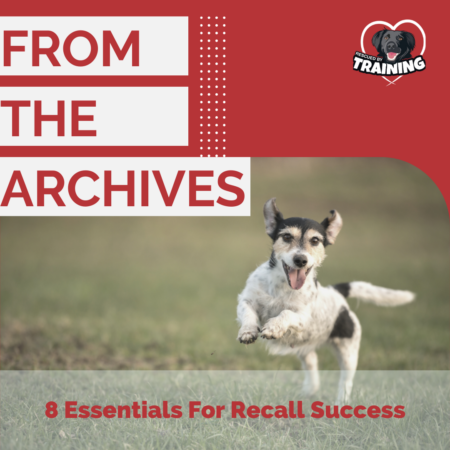Getting your dog to come when called (recall) is a potentially life saving behavior. In a worst-case scenario, you drop the leash or your dog slips out of a harness and takes off. You want to know that when you call him, he will come back. Recall is also one of the main things owners struggle with training on their own. Why is recall so hard for regular owners to train? One of the most common complaints I get from clients when they come to me is “he won’t come when called” or “he only comes if he feels like it.” So let’s talk about that!
First, recall doesn’t come naturally to dogs. Often when you call your dog to come to you, you’re competing with other, likely more interesting things, in your dog’s environment – other dogs, fast moving critters, or interesting smells. We need to realize this is an “expensive” behavior for your dog to perform. We’re essentially saying “Hey, I know you’ve got something interesting over there, but I’d like you to leave that and come to me instead.”
In some cases, your dog might be hypervigilant or afraid and in those cases your dog might be in survival mode, and coming when called just isn’t a priority. Survival or threat assessment is the priority.
But for non-fearful dogs, here a few key things to do to get a no fail coming when called. (There’s also a few things not to do.)
First, what not to do.
- Never punish a dog for not coming. If you call your dog and he doesn’t come, do not punish him. This is a sure-fire way to ensure he never comes to you in the future. And similarly, don’t ever call your dog to do something potentially scary like administer ear drops or medication.
- Don’t assume your dog has a recall. Unless you’ve specifically trained it and practiced it it in lots of safe scenarios, never let a dog off-leash in an unsecured area. I can’t even begin to count the number of dogs that have gotten lost, injured or killed because their owners assumed the dog would just come when called.
- Don’t be stingy with food. Recall is an “expensive” behavior for dogs to do. This means, they require a high paycheck (high value food) every single time they do it. If your boss asked you to do a really difficult project and you did it but then, instead of a nice fat bonus paycheck, you got a pat on the back and a “great job on that project” and that’s it, I’d guess next time you were asked to do a really hard project, you’d say no thanks. The same applies to dogs.
- Never use a shock collar. Besides all the scientific evidence telling us there is no need to ever use pain in training, you don’t want your dog coming to you because he’s afraid of being shocked. You got a family member, not a soldier. Here’s a great post that goes into detail why you should never shock your dog for recall (or ever.)
Now, what to do!
- Use a unique word or sound. A novel word or sound, something your dog never hears except for recall is what you want. You don’t want to use his name because you use that for lots of things and it doesn’t always mean “come to me.” I don’t even really like using come or here, because you use those in everyday conversation and your dog might hear those words when it isn’t addressed to him. I use a tongue trill for my own dogs but often use a high pitched “cheeeeese” when training client dogs. (more on that in #2)
- Reserve one super special, high-value (preferably human) food for recall. To help strengthen the behavior, and create a 1 to 1 association that your unique word predicts something amazing is about to happen, we reserve one super high-value food for recall. As you might imagine from point #1, I use cheese. Pecorino cheese specifically and most dogs love it and can tolerate it because it’s a hard cheese. They quickly learn that special sound is the only time they get this amazing treat.
- Pay with a jackpot payoff, every single time. Because recall is an expensive behavior for the dog to do (don’t chase that critter, come to me instead!) we need to reward it heavily when it happens. This means we give the dog a jackpot payout – feeding your special recall food consistency for 20-30 seconds every single time the dog comes when called. This is not the time to be stingy with food. This behavior could save your dog’s life one day.
- Practice incrementally. Building a solid recall means building a foundation. You must use an incremental plan that factors in distance (how far way your dog is from you when you ask him to come back) and distractions (other dogs, critters, food, people, inside vs outside, etc.). Just because your dog may come to you in the house where it’s familiar and boring doesn’t mean he will come to you at the dog park when he’s in the middle of play. We can certainly train a dog to recall out of play, but it has to be worked up to with a training plan.
If you’re struggling with recall, you can schedule a session so we can review things in more detail. Ruling out things like fear, can be important to your training process, so let’s work together to make a plan!
Happy training!
![]()




